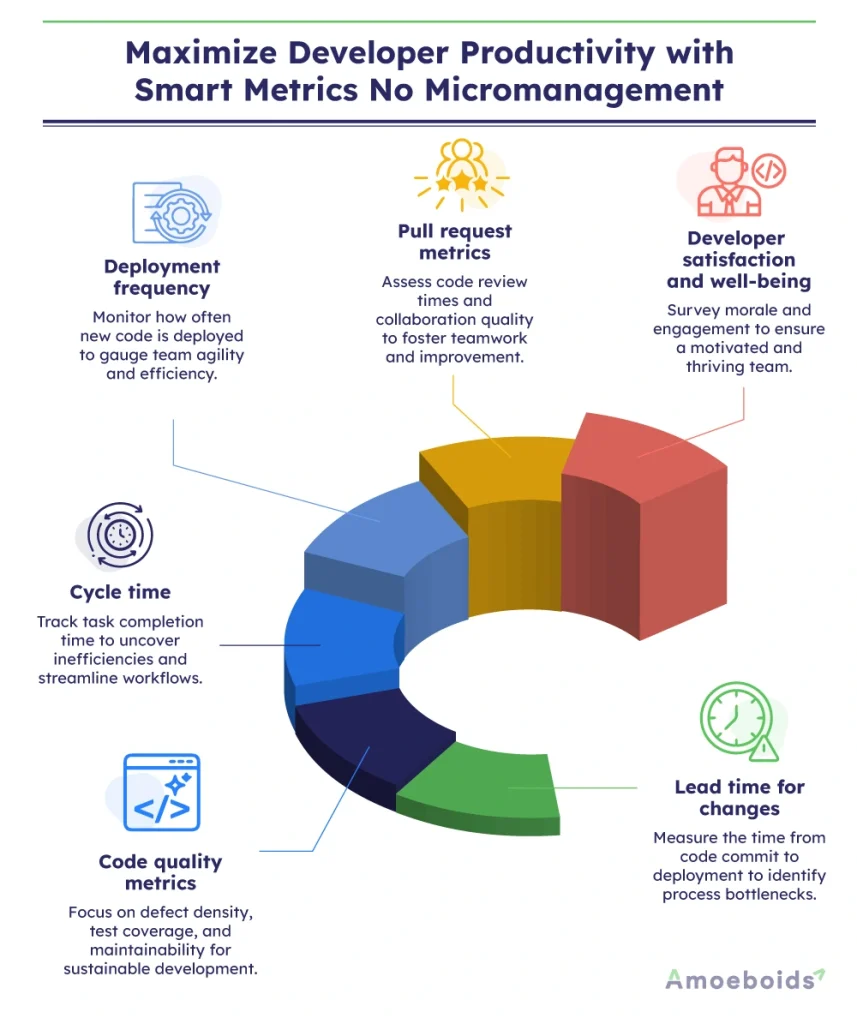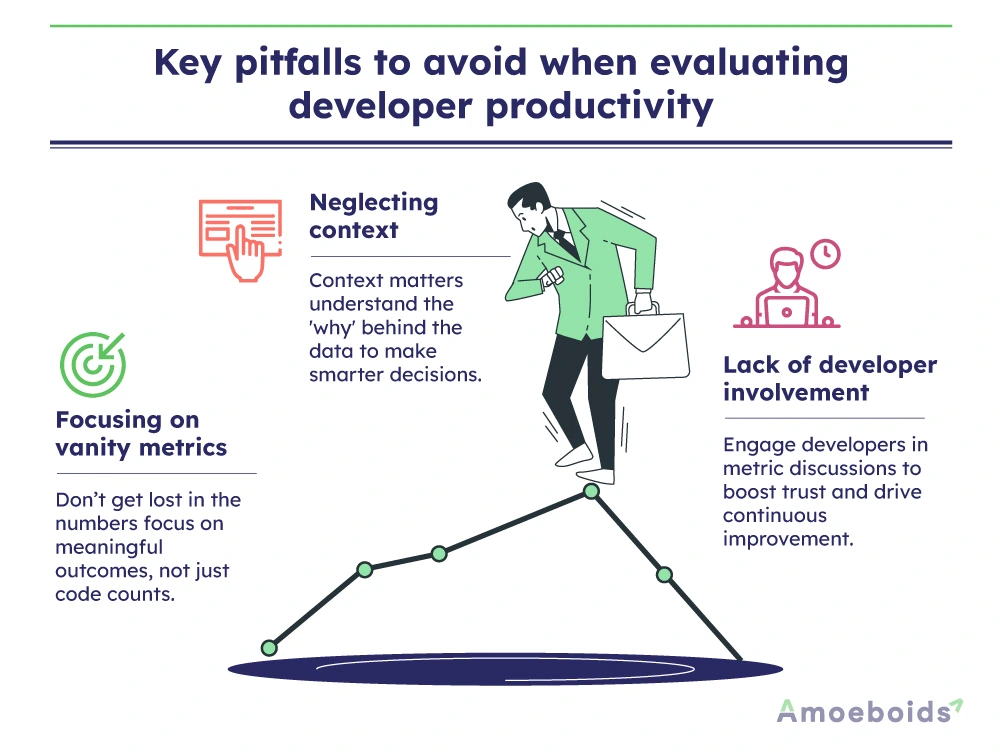Measuring developer productivity is a big challenge for tech leaders. On one hand, there’s the need to ensure that projects are on track and deliverables are met. On the other, imagine a developer feeling demoralized because their manager keeps questioning why a single feature took two days instead of one—this constant scrutiny can lead to frustration, disengagement, and even burnout.
This creates a dilemma: how do you ensure developers are productive without compromising their autonomy or the team’s morale? The good news is that there is a balance.
In this article, we’ll explore practical, non-intrusive strategies for measuring developer productivity that align with a healthy, supportive work culture.
Why should you measure developer productivity?
Measuring developer productivity matters because it fuels success on multiple levels—yours, your team’s, and the business as a whole.
For your business:
Clear productivity metrics ensure projects stay on track, timelines are met, and resources are used wisely. They give you a real-time view of your team’s progress, helping you make smarter, more informed decisions.
For your team:
Metrics highlight bottlenecks and inefficiencies, allowing you to address challenges and create opportunities for upskilling and collaboration within your team.
Individual development:
Measuring productivity provides constructive feedback that helps developers refine their skills, align with goals, and grow in their roles.
By measuring productivity thoughtfully, you can strike a balance between improving performance and supporting your people.
Action tip: Sometimes you work on complex projects that need more supervision. Visual cues, like project status reports, can go a long way without having to micromanage.
Why micromanagement doesn’t work
Micromanagement often stems from good intentions—leaders wanting to ensure progress or maintain high standards. However, the costs of this approach far outweigh any short-term gains.
Impact on developers
Micromanagement takes a significant toll on your team:
Stress and burnout
Constant oversight creates a high-pressure environment that leads to worry, fatigue, and eventually, burnout.
Stifled creativity
Developers lose the creative freedom they need to innovate and solve problems.
Job dissatisfaction
Feeling distrusted can demotivate your team and drive talent away.
Eroded trust
Excessive monitoring can make your developers feel like their privacy is being invaded. This can lead them to not trust you and not engage with the team.
While micromanagement might deliver a short-term boost in output, it comes at a steep cost. Over time, these issues lead to high turnover, disrupted projects, and increased hiring costs. By steering clear of micromanagement, you can cultivate a workplace where developers feel trusted, empowered, and motivated to excel.
Rethinking productivity metrics: Quality over quantity
In the traditional approach to measuring developer productivity, the focus is often on quantity: how many lines of code were written, how many tickets were closed, or how many releases were managed. While these metrics are easy to track, they can be misleading and fail to capture the true value of a developer’s work. For instance, a developer might close a large number of tickets, but if the features they implement don’t solve user problems or align with business goals, the impact is minimal.
Outputs vs. Outcomes:
- Outputs: These are the measurable activities like lines of code written or tickets closed. They provide a numerical snapshot of activity but often miss the bigger picture.
- Outcomes: These are the results that matter—delivering high-quality features that actually solve user problems and drive business goals. For example, instead of measuring how many tasks a developer completes, measure whether the features they’ve worked on improve the user experience or contribute to business growth.
The focus should shift from asking, “How much did they do?” to asking, “How impactful was their work?” A developer who spends a little more time refining a feature that significantly enhances the user experience is far more valuable than one who rushes to close dozens of tickets without considering the impact. By emphasizing outcomes over outputs, organizations can foster a result-driven culture where quality, innovation, and user satisfaction are prioritized.
Building a culture of trust and accountability
Building a culture of trust and accountability is essential for ensuring that productivity metrics serve the team rather than cause friction. When developers feel trusted and understand the purpose behind the metrics, they are more likely to engage with them positively. Here’s how you can cultivate such a culture:
Foster transparency
One of the most effective ways to build trust is by fostering transparency around productivity metrics. For example, if you implement a new tool to track development progress, clearly explain why it’s being introduced—perhaps to identify bottlenecks in the process or improve project timelines.
When developers understand the reasoning behind the metrics, they are more likely to see them as tools for improvement rather than as surveillance. Transparency helps eliminate uncertainty and encourages buy-in from the team.
Empower developers
Developers thrive when they feel they have control over their work. Let’s say you give a developer the freedom to decide how best to approach a complex feature.
Instead of micromanaging their process, you trust them to use their expertise to set their own deadlines and workflows. This autonomy motivates them to take ownership of their tasks, which often leads to better results.
By empowering developers, you reinforce trust in their capabilities and increase their investment in the success of the team.
Focus on collaboration
Emphasizing teamwork over individual performance is crucial for building a culture of trust. For instance, instead of rewarding the developer who closed the most tickets, recognize the entire team for delivering a high-quality feature that solves a major user problem. This approach fosters a sense of shared purpose, where developers help one another and work together to achieve common goals.
Collaboration enhances both productivity and job satisfaction, creating a team dynamic where everyone feels accountable to each other.
Now, let’s explore the metrics you should track to implement this approach.
Key metrics to track developer productivity without micromanagement
To ensure developer productivity without resorting to micromanagement, it’s crucial to track the right metrics. These metrics allow you to focus on the overall efficiency of the team and processes, not individual performance, fostering trust and autonomy. Here are six key metrics that can help:

Lead time for changes
This metric tracks the time it takes for a code change to move from commit to deployment. Often, delays are caused by the process itself, not individual developers. By measuring lead time, you can identify bottlenecks in the process—such as inefficient testing or deployment stages—without singling out a developer’s performance.
Why track it: It helps optimize workflows and streamline processes, allowing you to improve productivity without micromanaging each developer’s actions.
Cycle time
Cycle time measures the time from task initiation to completion. By tracking this metric, you can identify inefficiencies in task execution—whether it’s waiting for feedback, blocked dependencies, or unnecessary delays.
Why track it: This allows you to fine-tune your workflows and improve the overall efficiency of the team. By addressing bottlenecks without scrutinizing individual performance, developers maintain their autonomy while contributing to faster project delivery.
Code quality metrics
Metrics like defect density, maintainability, and test coverage focus on the robustness and scalability of the software being built. These quality metrics emphasize the outcome of the developer’s work rather than the volume of code written.
Why track it: By prioritizing quality, you encourage an environment where developers take pride in producing clean, maintainable code. This avoids a focus on quantity and encourages long-term, sustainable development practices, which leads to higher productivity without the need for constant oversight.
Deployment frequency
This measures how often new code is deployed to production, reflecting how efficiently the team collaborates and delivers value to users. A higher deployment frequency indicates that the team is agile and capable of releasing updates quickly.
Why track it: Tracking deployment frequency shifts the focus from individual tasks to team collaboration and overall agility. It encourages developers to work together to deliver value consistently, allowing them to work at their own pace without micromanagement while still achieving business goals.
Pull request metrics
Monitoring the time taken for code reviews and the quality of collaboration during the pull request process encourages knowledge sharing and collective improvement. These metrics assess how well developers communicate and review each other’s code, not just how fast they complete individual tasks.
Why track it: By focusing on the pull request process, you ensure that developers engage with each other constructively. This fosters a culture of collaboration and mutual support, where productivity increases through teamwork rather than through strict oversight.
Developer satisfaction and well-being
Regular surveys and feedback help assess the morale and engagement of your team. Happy, engaged developers are more productive and are less likely to burn out. This metric tracks factors like job satisfaction, work-life balance, and team dynamics, ensuring that developers are thriving.
Why track it: Fostering a positive work environment contributes to sustained productivity, as developers feel more motivated and supported. By monitoring well-being, you can proactively address issues before they lead to disengagement or burnout, all while respecting their autonomy.
By tracking these metrics, you can focus on outcomes rather than outputs, ensuring that productivity is measured holistically and without micromanagement. Now, let’s look at some of the tools that can help you track these metrics.
Tools for measuring productivity without micromanaging
To measure developer productivity without micromanaging, it’s essential to focus on the right metrics that reflect team outcomes rather than individual tasks. These tools allow you to track performance while maintaining a healthy, autonomous work environment that supports agile productivity.
Git Analytics Tools
Tools like Linear, Waydev, or GitPrime provide insights into code changes, pull requests, and overall workflows. They help identify bottlenecks in the development process, allowing you to streamline operations.
Project Management Tools
Jira, Trello, and Asana are project tracking tools that are made for Agile productivity. They can manage sprints, track tasks, and monitor project progress. They can ensure that developers stay aligned with team goals and deadlines, all while giving them the autonomy to manage their workloads. They can also help you create project reports with all the key elements, so your team can visually understand project statuses.
Code Quality Tools
SonarQube is a popular tool for measuring code quality, including maintainability, security, and bug detection. By integrating it into the workflow, your developers can focus on writing cleaner, more robust code, ensuring long-term stability without micromanagement.
Feedback Platforms
Tools like UpRaise for Employee Success provide platforms for gathering regular feedback on developer satisfaction and well-being. These insights are valuable for measuring team morale and identifying areas for improvement in work culture, ultimately helping you enhance productivity in a non-intrusive manner.
While tracking the right productivity metrics can greatly enhance team performance, it’s important to be aware of common pitfalls that can hinder progress. In the next section, we’ll explore these mistakes and how to avoid them for smoother, more effective management.
Common mistakes to avoid while measuring developer productivity
Measuring developer productivity requires a thoughtful approach to avoid missteps that can undermine team morale and effectiveness. Below are some key mistakes to steer clear of:

1. Focusing on vanity metrics
Relying on metrics like lines of code written or hours logged might seem helpful, but they only measure output, not value.
For example, a developer who writes a large amount of code may not be creating impactful features. Overemphasizing these metrics can lead to poor decision-making and distract from meaningful outcomes.
2. Neglecting context
Metrics can be misleading without context. For instance, if a developer takes longer to complete a task due to unexpected technical debt, a raw time metric might paint an unfair picture of their productivity.
Without understanding the circumstances behind the numbers, you risk drawing incorrect conclusions.
3. Lack of developer involvement
Excluding developers from the discussion about which metrics to track can breed distrust.
For example, if developers are unaware of the reasons behind tracking certain metrics, they might feel their work is being scrutinized unnecessarily. Involving developers in the process ensures they understand the purpose of the metrics and feel empowered to improve their workflows.
Now that we know some key mistakes to avoid while measuring productivity, let’s look at some best practices that are beneficial for you and your team.
Best practices for measuring developer productivity
To ensure your metrics are truly beneficial and drive both team and individual success, follow these best practices:
Analyze trends, not individuals
Focus on identifying patterns at the team level rather than singling out individuals. For example, if your team consistently takes longer to deploy updates, this could point to process inefficiencies rather than issues with specific developers.
Tracking trends encourages collaboration and long-term improvement across the team, rather than fostering unhealthy competition.
Incorporate feedback loops
Regular retrospectives or one-on-one meetings are key to discussing metrics and adjusting them as needed.
For instance, if developers feel certain metrics are misaligned with their work, open discussions can lead to a better, more supportive approach. These feedback loops promote continuous improvement and ensure that everyone is on the same page, in line with Agile principles.
Set clear goals
Establishing clear goals for the team ensures everyone knows the desired outcome. For example, if the goal is to reduce deployment time by 20%, developers can align their efforts accordingly, requiring less day-to-day management. This clarity fosters independence and allows developers to stay focused on outcomes without constant oversight.
Celebrate wins
Recognizing achievements, both big and small, boosts morale and motivates your team. For instance, celebrating the successful launch of a new feature or a sprint completed on time can strengthen team cohesion. Acknowledging success fosters a culture of appreciation, encouraging the team to keep delivering their best work.
By incorporating these best practices, you’ll create a productive, autonomous team that thrives on collaboration and continuous improvement.
Maximize developer productivity without micromanaging
Measuring developer productivity is crucial for creating a thriving, results-driven team. However, it’s essential to focus on the impact of work rather than just the tasks completed. By adopting non-intrusive strategies that emphasize outcomes, collaboration, and trust, you empower your developers to take ownership of their work while ensuring high-quality results.
With the right approach, you can nurture a productive environment where developers are motivated, engaged, and aligned with the team’s goals.



